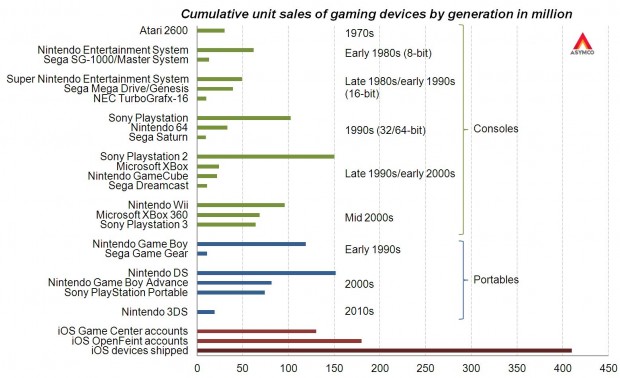At this year’s WWDC Apple offered an update on Game Center accounts. The data we have so far is shown in the following graph.
Before being acquired, another network, OpenFeint, announced 180 million iOS accounts in October 2011. Another figure to consider is the 40 million subscribers to Xbox Live (out of 66 million Xbox users). This subscriber base is paying for a service (about $1 billion per year) so it’s not the same as the free Game Center model.
Rather than being a revenue source, Game Center is designed to engage users and to capture usage information. It also lets us gauge gaming “consumption” on iOS devices. That itself allows us to contemplate it as a gaming platform vis-à-vis alternate platforms.
To consider the figure as a proxy of penetration and engagement, the graphic below shows cumulative sales of gaming devices.[1]
Here are some observations:
- There is a pattern of turnover of market participants
- Each console “generation” had a clear market leader
- The best-selling gaming device was the Nintendo DS closely followed by the PlayStation 2 [2]
- Considering the 130 million Game Center accounts, iOS is already the third largest gaming platform
- Furthermore, considering the OpenFeint iOS figure of 180 million accounts announced in 2011, iOS has already surpassed the cumulative sales figures for the Nintendo DS
- No gaming device has ever reached the 200 million mark
- At the current growth rate the number of Game Center accounts will surpass 200 million before the year end
Apple cites the number of games, downloads and payments to developers as evidence of ecosystem health and growth. The figure of Game Center accounts is yet another indicator. It shows growth in and of itself, but it also has the side effect of offering comparative measurement of performance. That measurement compares favorably with other game platforms.
The economics are different but they always are when a disruption takes root.
—
Notes:
- Based on reported cumulative sales (Wikipedia), excluding gaming devices with less than 10 million cumulative sales (excludes for example PlayStation Vita), excludes also “home computers” due to missing reported figures
- This Wikipedia article contradicts the previous.
Discover more from Asymco
Subscribe to get the latest posts sent to your email.


